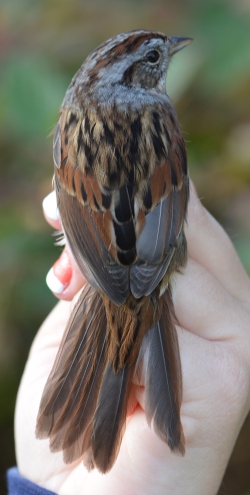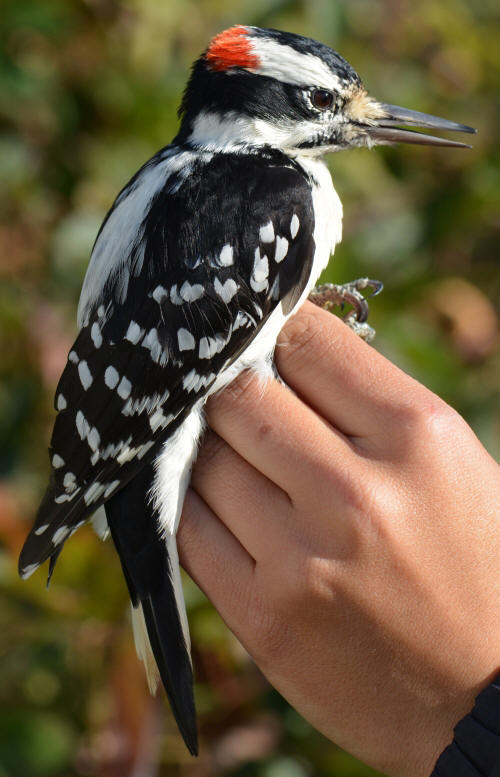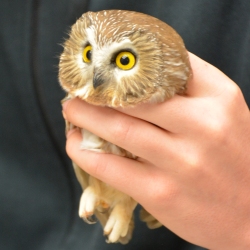October - November 6, 2015

As we noted in our Early Fall Update, the Late Fall was slower than expected due to the effect of wind on banding operations. Even so, over this five-week period, we banded almost half of the birds for the entire Fall (2,599) and processed another 1,344 recaptures.

September, as usual, brought the highest species diversity, with 46 species banded on September 22nd. In fact, all of the top five dates for species diversity were between September 22 and the 2nd of October. However, we had to wait until October 24th for our highest capture day, on which we banded 271 birds. Ruby-crowned Kinglets (65) represented 24% of captures on this day. A few late-Fall migrant sparrows and one warbler also made the top five species list for our busiest day: Dark-eyed Junco, 61; White-throated Sparrow, 42; Song Sparrow, 25; and Myrtle (Yellow-rumped) Warler, 23. These five species represented 80% of all captures for this end-of-season high.

Since sparrows were present in good numbers throughout all of the late-Fall season, not just on the highest-capture day, it seems fitting to include them in our Late Fall Pictorial Highlights. We banded nine species of sparrows this year for a total of 636 individuals (almost 25% of all birds for this five-week period). If we add in two other species of the Emberizidae family, the Dark-eyed Junco and the Eastern Towhee, those totals rise to 996 birds and almost 40% of our totals. The most frequently banded sparrow over this time frame was the White-throated Sparrow (pictured at left), which is a very good example of a late-Fall migrant-- we banded 263 this Fall, with all but twobanded after October 1st.

According to Pyle's Identification Guide to North American Birds, the Emberizidae family members have "generally subdued plumages, thick seed-eating bills and short wings." These subdued plumages can often make identification difficult for birders. One helpful observation is to note whether the breast has streaks (such as on the Savannah Sparrow at the left) or an unstreaked breast like the White-throated Sparrow above. This Savannah Sparrow, from October 21st, was the only one of its kind that we banded this season. Other field marks for this species are the yellow lores, and a thinner bill.1st.

The Fox Sparrow is a larger sparrow with more red in its plumage and chevron-shaped streaks on the breast. We banded 45 of this species, our first on October 18th.bill.1st.

The Lincoln's Sparrow has a buffy wash to the face and breast as well as streaks that look as though they were painted on with a fine brush. Their migration is not quite as late as some other Emberizidae members-- we banded 41 Lincoln's Sparrows from September 13 through October 31st.
Interestingly, in November, we received a Recovery report from the National Banding Lab about a Lincoln's Sparrow that we banded mid-morning on the 2nd of October. After a 322-mile journey to the west and slightly south of our station it was re-caught eight days later, by another bander on staff at the University of Cincinnati who was banding in Otto Armleder Park that morning. After some quick measurements, the sparrow was released to continue on it journey towards its wintering grounds, most likely in the southwestern United States or Mexico.


Two sparrows that are quite similar are the Song Sparrow (far left) and the Swamp Sparrow. Note that the Song Sparrow has thick streaks that come to a prominent spot on the breast while the colors on the breast of the Swamp Sparrow are smudgy and indistinct. While both have a strong eyeline and a similar head pattern, only the Song Sparrow has a distinct moustachial stripe.outhwestern United States or Mexico.


In these posterior views of the same two birds from above, notice the gray on the head of the Swamp Sparrow (right) as well as its warm rufous tones overall.
Along with the White-throated Sparrow, these two species completed the top three sparrow list for Late-Fall. Coming in at number two were the Song Sparrows, of which we banded 227 this Fall, with 176 of those (78%) banded in the month of October. We banded 125 Swamp Sparrows, with 105 (84%) caught in October.thwestern United States or Mexico.

Another sparrow with a plain, unstreaked breast is the Field Sparrow. These individuals can be identified by the slightly smaller size than the Song or Swamp Sparrow and the distinctive pink bill. We banded 27 Field Sparrows this Fall, all but one in the month of October.

The White-crowned Sparrow is another sparrow with no streaking and a pinkish bill. Even in this tan juvenal plumage this larger sparrow is one handsome bird (banded October 23rd). We saw just four of these sparrows in our nets this Fall, all of them in the the last two weeks of October. Sparrows not pictured which we banded this Fall: Chipping Sparrow (12) and House Sparrow (5).

The female Indigo Bunting (pictured at left, adult) is a bird that people often want to group with the sparrows. Similar in size and plumage with a similar bill shape, they often confound new birders. Look for a subtle blue hue at the bend of the wing and on the edges of the tail feathers.

Although many of the warbler species migrate early, there are a few around in October. One late-Fall migrant is the Myrtle (Yellow-rumped) Warbler, of which we banded 305 this Fall. Just like the White-throated Sparrow, all but two of these were banded after October 1st. The distinctive rump patch for which it is named is clearly visible on this hatch-year male banded on October 22nd.

We were also able to get a lucky shot of the less-visible yellow under-wing patch.ber 22nd.

Other warblers that came through our station in October were this hatch-year female Black-throated Green Warbler, one of 103 banded this Fall. Unlike the sparrows, most (78) of these were banded in September.

The female Orange-crowned Warbler is another species that birders often have a harder time identifying. This diminutive, hatch-year warbler was banded on October the 5th. She was one of three banded this fall-- the other two were banded on October 18 and 23.

One look at the crown of this warbler, with just a few orangeish feathers, was enough to clinch the ID. Undertail coverts are also helpful for this species-- yellow around the vent whereas similar species show white in that area.

If you think this Blackpoll Warbler looks a little too round, you're right! This individual had put on some serious fat deposits in preparation for his long migratory journey. This hatch-year male was the last of 10 Blackpoll Warblers we banded between the 1st and the 14th of October.ea.

Other pictorial highlights include this hatch-year Hermit Thrush with its notable reddish tail and warm tones throughout. This was one of 44 banded in October; we would band one more in November for a total of 45.

While we had them together in the lab, we thought it would be a good comparison to get a shot of this male (left, with the thick black moustachial stipe) and female Northern Flicker. These second-year individuals, banded on October 30th, were two of seven banded at our station this season.

We had a better-than-average year for Hairy Woodpeckers (long-term average, 1.32); this year, we banded eight! This hatch-year male was banded on October 21st. Identical to the Downy Woodpecker by plumage, this species is larger with a heavier bill.

Lastly, we couldn't help sharing another beautiful shot of an adult male Eastern Bluebird, one of two caught on October 17th, the only bluebirds banded this Fall.




And then there were owls...
We target-net (with an audio lure) the diminutive Northern Saw-whet Owls starting around mid- to late-October. Each has its own 'personowlity'--some are quiet docile and calm in the hand while others seem quite angry (like the individual at the bottom left).
This year we caught 12 Saw-whets. Ten were unbanded, two were recaps. All were caught between November 3rd and 22nd except for one, banded on October 25th.
Both of the recaptured owls were encountered on November 3rd. One was a four-year-old banded in Garrett County, Maryland in 2012 as a hatch-year bird.
The other recap was also banded as a hatch-year, but in this same calendar year. Banded on October 22 in Cayuga, Ontario, it traveled 329 miles due south over 12 days until it showed up in our net.ded this Fall.


Often the molt limits on the Saw-whet Owls are easy to see, as in the top photo where there is a block of retained, faded flight feathers in the middle of the wing flanked by a newer generation of feathers.
However, under a UV light shone on the ventral surface of the same wing (bottom photo), that block of feathers really stands out. It also allows us to make sure we haven't missed a more subtle difference that might represent the presence of a third generation of feather growth.
The UV light causes porphyrin pigments in the owl's feathers to fluoresce. These pigments degrade as the bird ages, so newer feathers show bright pink while older feathers lose the fluorescence. The pattern here is a typical second-year molt replacement. The middle, faded flight feathers were grown in the nest the prior year while the bright pink feathers are newly replaced this Fall.iles due south over 12 days until it showed up in our net.ded this Fall.

In an amazing display of nest site fidelity, we'd like to close with a story about one of our "regular" Gray Catbirds. On June 16th, 2006 we banded a second-year Catbird (hatched in 2005) that already had a brood patch (indicating that this was a female with an active nest nearby). That first year, we caught her two more times, on July 9th and July 12th, still in breeding condition at these subsequent encounters.
In the nine years following her first capture, she would visit Powdermill every year, and usually only show up in our nets just once (in 2013 it was twice, four days apart in August). In 2007 and 2008 she was re-caught in the first half of May; From 2009 through 2014 she was caught during August and September; on four of those occasions she had a brood patch that was scored as a 4 (drying up) or 5 (re-feathering), indicating that she was at the end of her breeding season. This year, at ten years old, she showed up on October 2nd and was sexed as "unknown" since it was late enough in the season that she no longer had a brood patch, or she may have had an unsuccessful breeding season.
Since 2009 we have been tracking the location of each net for our captures, and, interestingly, in the last seven years, this lady has ONLY been caught in each of four nets surrounding the small Alder Pond just outside the banding lab. The longevity record for a Grey Catbird stands at almost 18 years old, so we are hopeful that this faithful breeder will show up at Powdermill for many years to come!

Fall 2016 staff photo: leading the charge (and the banding efforts), our Banding Coordinator, Luke DeGroote; in the middle: seasonal banding assistants, Nick Glover (L) and Liz Abraham; and bringing up the rear: seasonal banding assistant Laura Gomez (L) and flight tunnel technician, Lauren Horner. Not pictured: banding assistant Mary Shidel (taking the photo).
As we close out the season, we are reminded how lucky we are to have a dedicated pool of volunteers, without whom we would never be able to do all that we do here at PARC. Many thanks to Gigi, Zara, Phil, Nick, John and Mac. And a special shout out to our long-distance volunteers, Jim and Debbie.
